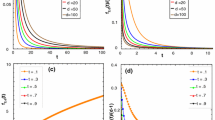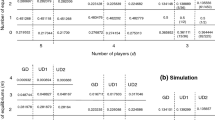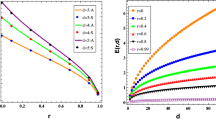Abstract
In this paper, we analyze the mean number \(E(n,d)\) of internal equilibria in a general \(d\)-player \(n\)-strategy evolutionary game where the agents’ payoffs are normally distributed. First, we give a computationally implementable formula for the general case. Next, we characterize the asymptotic behavior of \(E(2,d)\), estimating its lower and upper bounds as \(d\) increases. Then we provide a closed formula for \(E(n,2)\). Two important consequences are obtained from this analysis. On the one hand, we show that in both cases, the probability of seeing the maximal possible number of equilibria tends to zero when \(d\) or \(n\), respectively, goes to infinity. On the other hand, we demonstrate that the expected number of stable equilibria is bounded within a certain interval. Finally, for larger \(n\) and \(d\), numerical results are provided and discussed.

Similar content being viewed by others
References
Abel NH (1824) Mémoire sur les équations algébriques, où l’on démontre l’impossibilité de la résolution de l’équation générale du cinquiéme degré. Abel’s Ouvres 1:28–33
Altenberg L (2010) Proof of the Feldman–Karlin conjecture on the maximum number of equilibria in an evolutionary system. Theor Popul Biol 77(4):263–269
Broom M, Cannings C, Vickers GT (1993) On the number of local maxima of a constrained quadratic form. Proc R Soc Lond A 443:573–584
Broom M, Cannings C, Vickers GT (1994) Sequential methods for generating patterns of ESS’s. J Math Biol 32(6):597–615
Broom M, Cannings C, Vickers GT (1997) Multi-player matrix games. Bull Math Biol 59(5):931–952
Broom M, Rychtar J (2013) Game-theoretical models in biology. CRC Press, Boca Raton
Edelman A, Kostlan E (1995) How many zeros of a random polynomial are real? Bull Am Math Soc (N.S.) 32(1):1–37
Fudenberg D, Harris C (1992) Evolutionary dynamics with aggregate shocks. J Econ Theory 57:420–441
Gross T, Rudolf L, Levin SA (2009) Generalized models reveal stabilizing factors in food webs. Science 325:747–750
Gokhale CS, Traulsen A (2010) Evolutionary games in the multiverse. Proc Natl Acad Sci USA 107(12):5500–5504
Haigh J (1988) The distribution of evolutionarily stable strategies. J Appl Probab 25(2):233–246
Haigh J (1989) How large is the support of an ESS? J Appl Probab 26(1):164–170
Hardin G (1968) The tragedy of the commons. Science 162:1243–1248
Hauert C, De Monte S, Hofbauer J, Sigmund K (2002) Replicator dynamics for optional public good games. J Theor Biol 218:187–194
Han TA, Pereira LM, Lenaerts T (2015) Avoiding or restricting defectors in public goods games? J R Soc Interface 12(103). doi:10.1098/rsif.2014.1203
Hart S, Rinott Y, Weiss B (2008) Evolutionarily stable strategies of random games, and the vertices of random polygons. Ann Appl Probab 18(1):259–287
Hofbauer J, Sigmund K (1998) Evolutionary games and population dynamics. Cambridge University Press, Cambridge
Han TA, Traulsen A, Gokhale CS (2012) On equilibrium properties of evolutionary multi-player games with random payoff matrices. Theor Popul Biol 81(4):264–272
Karlin S (1980) The number of stable equilibria for the classical one-locus multiallele selection model. J Math Biol 9:189–192
Karlin S, Feldman MW (1970) Linkage and selection: two locus symmetric viability model. Theor Popul Biol 1:39–71
Kostlan E (1993) On the distribution of roots of random polynomials. In: From topology to computation: proceedings of the smalefest (Berkeley., CA, 1990), Springer, New York, pp 419–431
Kostlan E (2002) On the expected number of real roots of a system of random polynomial equations. In: Foundations of computational mathematics (Hong Kong, 2000). World Scientific Publishing, River Edge, pp 149–188
Kontogiannis SC, Spirakis PG (2009) On the support size of stable strategies in random games. Theor Comput Sci 410(8):933–942
Levin SA (2000) Multiple scales and the maintenance of biodiversity. Ecosystems 3:498–506
McLennan A, Berg J (2005) Asymptotic expected number of Nash equilibria of two-player normal form games. Games Econ Behav 51(2):264–295
McLennan A (2005) The expected number of Nash equilibria of a normal form game. Econometrica 73(1):141–174
Maynard-Smith J (1982) Evolution and the theory of games. Cambridge University Press, Cambridge
Nowak MA (2006) Evolutionary dynamics. Harvard University Press, Cambridge
Packer C, Caro TM (1997) Foraging costs in social carnivores. Animal behaviour 54(5):1317–1318
Pacheco JM, Santos FC, Souza MO, Skyrms B (2009) Evolutionary dynamics of collective action in n-person stag hunt dilemmas. Proc R Soc B 276:315–321
Sigmund K (2010) The calculus of selfishness. Princeton University Press, Princeton
Schuster P, Sigmund K (1983) Replicator dynamics. J Theo Biol 100:533–538
Santos FC, Santos MD, Pacheco JM (2008) Social diversity promotes the emergence of cooperation in public goods games. Nature 454:213–216
Stander PE (1992) Cooperative hunting in lions: the role of the individual. Behav Ecol Sociobiol 29(6):445–454
Taylor PD, Jonker L (1978) Evolutionary stable strategies and game dynamics. Math Biosci 40:145–156
Tao T, Vu V (2014) Local universality of zeroes of random polynomials. Int Math Res Not 16(2). doi:10.1093/imrn/rnu084
Vickers GT, Cannings C (1988) On the number of equilibria in a one-locus, multi allelic system. J theor Biol 131:273–277
Vickers GT, Cannings C (1988) Patters of ESS’s I. J theor Biol 132:387–408
Vickers GT, Cannings C (1988) Patters of ESS’s II. J theor Biol 132:409–420
Wu B, Traulsen A, Gokhale CS (2013) Dynamic properties of evolutionary multi-player games in finite populations. Games 4(2):182–199
Zeeman EC (1980) Population dynamics from game theory. Lect Notes Math 819:471–497
Acknowledgments
We would like to thank members of the WMS seminar at the CASA at Eindhoven University of Technology, especially Dr. R. van Hassel and Prof. A. Blokhuis for useful discussion. Part of this work was done under the support of the F.W.O. Belgium (TAH, postdoctoral fellowship 05_05 TR 7142).
Author information
Authors and Affiliations
Corresponding author
Appendix
Appendix
1.1 Properties of \(a_k\)
In the following, we prove that \(a_{2d-4-k} = a_k\) for all \(0 \le k \le 2d-4\), i.e., (22). First, we transform \(a_k\) as follows
Now we prove that \(a_{2d-4-k} = a_{k}\). Indeed, we have
Since for \(j = -1\) and \(i = k\), we have
and for \(j = d-2\) and \(i = k-1 - (d-2)\), we have
it follows that \(a_{2d-4-k} = a_k\) for all \(0 \le k \le 2d-4\).
1.2 Detailed Computation of \(f(1)\)
We use the following identities involving the square of binomial coefficients.
Therefore, we have
where we have used the identity \(\begin{pmatrix} 2(n+1)\\ n+1 \end{pmatrix}=\frac{n+1}{2(2n+1)}\begin{pmatrix}2n\\ n \end{pmatrix}.\)
1.3 Alternative Proof of the Fifth Property in Lemma 2
We show here an alternative proof of the fifth property without using the first one in Lemma 2.
Since \(M_d\left( \frac{1}{t}\right) =t^{2(1-d)M_d(t)}\), we have
Therefore, from (26), we have
and
Hence,
Therefore,
1.4 Proof of Lemma 3
Denoting \(\varSigma = 1+\sum _{k=1}^{n-1} t_k^2\), we have
Rights and permissions
About this article
Cite this article
Duong, M.H., Han, T.A. On the Expected Number of Equilibria in a Multi-player Multi-strategy Evolutionary Game. Dyn Games Appl 6, 324–346 (2016). https://doi.org/10.1007/s13235-015-0148-0
Published:
Issue Date:
DOI: https://doi.org/10.1007/s13235-015-0148-0




